Compiled by Tom Lake, Hudson River Estuary Program Consulting Naturalist
Overview
The winter irruption of pine grosbeaks continued this week with its epicenter in Washington County. Among the scores of wintering bald eagles on the Hudson River was one carrying a gold band. Its story reminds us once again how we are connected to places far and wide. In the Hudson River, the first glass eels of the season arrived.
Highlight of the Week
2/26 – Peekskill, HRM 43: There was a mix of adult and immature bald eagles out on the ice in Peekskill Bay. One adult caught my attention as it was banded on both legs. Through my camera lens, I was able to discern three digits (WR7) on a gold band on its left leg. (The right leg had a silver U.S. Fish & Wildlife band). As I watched, four other adults hounded the banded bird for a fish. Yet it was an immature eagle that finally stole the gizzard shad. Recognizing the gold band as one of the two colors used by the Massachusetts Division of Fisheries and Wildlife (the other being orange), I contacted Thomas French.
- Bonnie Coe
[Thomas French replied that this banded eagle was a male and its complete band number was 0629-48136, WR7 gold. The bird was banded as a fledgling on August 17, 2005, in Deerfield, MA, near the Connecticut River, making the eagle now 14 years-old. Since he is an established local nesting bird in Massachusetts, his presence on the Hudson River marks him as a wintering bird.]
Natural History Entries
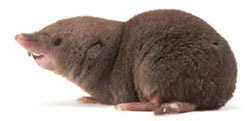 2/23 – Minerva, HRM 284: One of our cats is a pretty good mouser. This morning, I found a deceased short-tailed shrew on the kitchen floor, no doubt courtesy of the mouser. I had caught one this past summer in a standard trap, but here was one in mid-winter. Quite odd, I reckon. Meanwhile, we had three feet of snow on the ground. (Photo of short-tail shrew courtesy of Joel Satore) 2/23 – Minerva, HRM 284: One of our cats is a pretty good mouser. This morning, I found a deceased short-tailed shrew on the kitchen floor, no doubt courtesy of the mouser. I had caught one this past summer in a standard trap, but here was one in mid-winter. Quite odd, I reckon. Meanwhile, we had three feet of snow on the ground. (Photo of short-tail shrew courtesy of Joel Satore)
- Mike Corey
[The northern short-tailed shrew (Blarina brevicauda) is a native and widespread mammal found in the southern half of eastern Canada and the eastern half of the U.S. They favor the mixed and deciduous hardwood forests with thick, damp leaf-mold in the Adirondacks. Adults weigh 15-23 grams and their average length is 120 millimeters. The cold temperatures and deep snows of an Adirondack winter do not suppress the activity of the short-tailed shrew. It tunnels through the snow and forages on the surface, usually at night, or burrows just beneath the surface. Adirondack Ecology Center, ESF Newcomb]
[Note: one inch = 25.4 millimeters (mm)]
2/23 – Washington County, HRM 193: I walked along South Main Street in Salem this afternoon and all I could hear was the monkey-like sounds of pine grosbeaks. I found them near the two crabapple trees where they were previously. They were in both trees, on rooftops, and on the ground. My count went up to 42 birds, but I could still hear a bunch of them in a tall Norway spruce across the road. I guessed that there were 50 birds or more, yet I had not found a single male. They are very cool birds with a bubbly personality.
- Scott Varney (Hudson-Mohawk Bird Club)
2/23 – Albany, HRM 145: In late afternoon, I found the red-throated loon I first reported six days ago. The loon was in the Hudson River at the Corning Preserve, diving frequently and moving upriver before it turned back just above the boat launch.
- Craig Driggs (Hudson-Mohawk Bird Club)
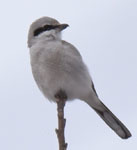 2/23 – New Paltz, HRM 78: We were at the Nyquist-Harcourt Wildlife Sanctuary when we spotted a northern shrike. The shrike was gurgling to itself and posing quite cooperatively. (Photo of northern shrike courtesy of Peter Heidrich) 2/23 – New Paltz, HRM 78: We were at the Nyquist-Harcourt Wildlife Sanctuary when we spotted a northern shrike. The shrike was gurgling to itself and posing quite cooperatively. (Photo of northern shrike courtesy of Peter Heidrich)
- Nancy Ebel, Peter Heidrich
[The northern shrike (Lanius excubitor) is a boreal songbird whose presence in the Hudson Valley is often associated with severe winter weather to the north. They are often in migration from near-Arctic breeding grounds to Mid-Atlantic wintering sites. They have a raptor-like appearance and will often impale their prey (smaller songbirds) on thorns or barbed wire. This has earned them the scientific name for their genera, Lanius, Latin for butcher. Tom Lake]
*** Fish of the Week ***
With winter here and much of the watershed’s ponds, creeks, lakes, and rivers iced-over, some of us are going through fish withdrawal. As a coping device, until fully open water returns in March, we will have a “Fish of the Week” feature.
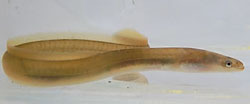 2/24 – Hudson River Watershed: We are fast approaching the season when educators, naturalists, scientists, and their students will catch, count, measure, and study “glass eels” in the Hudson River Estuary. This natural connection takes us to this week’s fish, the American eel (Anguilla rostrata), species number 19 (of 228) on our watershed list of fishes. (E-mail trlake7@aol.com if you would like a copy.) 2/24 – Hudson River Watershed: We are fast approaching the season when educators, naturalists, scientists, and their students will catch, count, measure, and study “glass eels” in the Hudson River Estuary. This natural connection takes us to this week’s fish, the American eel (Anguilla rostrata), species number 19 (of 228) on our watershed list of fishes. (E-mail trlake7@aol.com if you would like a copy.)
The story of glass eels begins with the American eel, a fish whose life history is shrouded in mystery. Their ancestors have survived global cataclysms for millions of years but now some populations of freshwater eels appear to be diminishing, and scientists are not quite certain why. While American eels are considered a freshwater fish, they are born at sea before slowly migrating inland where they spend much of their lives in the fresh and brackish waters of the upland watershed. “Glass eels” are one of the juvenile life stages of the American eel. They arrive in the estuary by the millions each spring following a six-month to year-long journey from the greater Sargasso Sea area of the North Atlantic where they were born. Glass eel is a colloquial name owing to their lack of pigment and near transparency. These are juvenile American eels “returning” to the estuaries of their ancestors along the east coast of North America. This is a particularly vulnerable time for them and little is known about this period in their life history. In anywhere from 10-30 years, depending upon their sex, they will leave the Hudson River watershed for the sea where they will spawn once and then die, or so we think. (Photo of American eel courtesy of Tom Lake) - Tom Lake
2/24 – Verplanck, HRM 40.5: As the tide was coming in today, we watched ice floes moving very rapidly in both directions: inshore ice upriver; channel ice downriver. Was this the great “Mahicanituk,” the river that flows both ways?
- Dianne Picciano
[The river phenomenon that Dianne Picciano observed was not an illusion but rather is caused by the physics of water depth and current velocity. Current is a horizontal measurement of tidewater movement; tide is the vertical measurement of tidewater movement. Often the river will cease to rise or fall (tide), but the Hudson will continue to flow up or down the river (current).
An ebb tide in deep water takes longer to slow down and stop compared to inshore waters. Thus, the start of the flood can begin inshore before the ebb is fully stopped in the deeper channel. In the language of the original Algonquian-speaking residents of the valley, their word “Mahicanituk,” is generally translated as “the river that flows both ways.” It is possible that this is the phenomenon that we hear from Indian folklore, and not simply just the four tides each day. - Tom Lake]
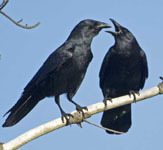 2/24 – Croton River, HRM 34: I found a coterie of fish crows this morning at the confluence of the Croton River and Croton Bay. To the crows, it was love in springtime: A pair were perched 30 feet away on a guardrail, stroking and caressing one another. In the canopy of a nearby cottonwood, another fish crow was presenting a bit of unidentifiable food to an admirer. “Ok-a-lee,” the call of the male red-winged blackbird, echoed from the tidemarsh. (Photo of fish crows courtesy of R.W. Sinclair) 2/24 – Croton River, HRM 34: I found a coterie of fish crows this morning at the confluence of the Croton River and Croton Bay. To the crows, it was love in springtime: A pair were perched 30 feet away on a guardrail, stroking and caressing one another. In the canopy of a nearby cottonwood, another fish crow was presenting a bit of unidentifiable food to an admirer. “Ok-a-lee,” the call of the male red-winged blackbird, echoed from the tidemarsh. (Photo of fish crows courtesy of R.W. Sinclair)
- Christopher Letts
[Fish crows (Corvus ossifragusx) are a bit smaller on average than the American crow (C. brachyrhynchos) and have a call that is more like “ca” than the full throaty “caw” of the American crow. Their ranges are similar but fish crows are more inclined to be found near water. Legendary ornithologist Heinz Meng offered that the call of the fish crow was like that of an American crow with a head cold. In keeping with his sense of humor, Dr. Meng also taught us how to remember the pronunciation of the trivial name of the American crow (brachyrhynchos), as “black-as-inkis.” Tom Lake]
2/25 – Hudson River Valley: In the wake of a winter storm, eastern New York experienced 36-hours of high west winds, often sustained at 25 to 40 miles-per-hour (mph), with gusts to 65 mph. With nighttime air temperatures in the low 20s Fahrenheit, the windchill was near zero. The National Weather Service characterized it as an “intense wind event” with trees down and thousands of homes losing electricity. Many areas along the estuary witnessed “blow-out tides.”
- Tom Lake
[Blowout tides are not common. They occur most frequently following several days of steady and strong north-northwest winds. According to Dr. Alan F. Blumberg, director of the Center for Maritime Systems at the Stevens Institute of Technology, blowout tides result from these winds acting on the ocean off New York Harbor, causing extremely low tides there and in turn up the Hudson. It culminates in an ebb tide that seems to go seaward forever, draining tide marshes and inshore shallows to give us a glimpse of seldom seen parts of river bottom. Tom Lake]
2/25 – Dutchess County, HRM 69: I was driving near the river early this morning and the strong winds were challenging my vehicle. I wondered if all the animals were hiding away somewhere, hoping a tree doesn’t fall on them. Then I looked up in the sky and spotted a raptor with its wings tucked in, reminding me of a falcon. It was an adult red-tailed hawk trying to control its flight in the gusts of wind. The hawk tried to dip down for a landing, but another gust threw the raptor into barrel rolls in the sky. I was astonished at how the hawk managed to regain control, pulled in its wings, and tried again to dip down for a landing, this time crashing through branches and finally gripping one with its talons. The entire tree was rocking, and I could see the bird’s creamy-white-streaked chest feathers swaying with the wind.
- Lauren Martin
2/25 – Verplanck, HRM 40.5: We had been watching a lone snow goose at the waterfront since last November. At first, we thought the goose might have been injured as it was not flying much. However, the snow goose quickly joined a flock of local Canada geese and they have all been here since. We see the snow goose every day and it appears to be healthy. In the next month or so, we will find out what its options are: Will it join a northward bound flock of snow geese heading to their Arctic tundra breeding grounds, or will it stay with its adopted extended “family”?
- Dianne Picciano
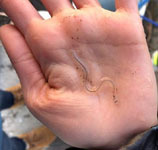 2/26 – Yonkers, HRM 18: When my 9 to 11th grade students from the Bio-Chem program at Saunders High School in Yonkers checked our eel mop today, it brightened an otherwise sunny and cold winter day: We found our first glass eel of the year! The water flowing out of the Saw Mill River into the Hudson was 41 degrees Fahrenheit (F.). (Photo of glass eel courtesy of Harry Hall) 2/26 – Yonkers, HRM 18: When my 9 to 11th grade students from the Bio-Chem program at Saunders High School in Yonkers checked our eel mop today, it brightened an otherwise sunny and cold winter day: We found our first glass eel of the year! The water flowing out of the Saw Mill River into the Hudson was 41 degrees Fahrenheit (F.). (Photo of glass eel courtesy of Harry Hall)
- Harry Hall
[Eel mops are a basketball-sized tangle of polypropylene tentacles placed in the river and found by glass eels to be a very cozy way-station on their trip upstream. The mop can be lifted out and shaken, and the glass eels will fall into a waiting bucket. The Atlantic State Marine Fisheries Commission literature has the perfect name for the mops: Medusa device. Medusa was a priestess in Greek mythology. In a fit of anger, the Greek goddess Athena, daughter of Zeus, transformed Medusa’s hair into a head of snakes. As the eel mop gyrates in the current, it conjures up that image. Tom Lake]
2/27 – Newcomb, HRM 302: We had pine grosbeaks here early in the winter season (November, December) but we have not seen any since Christmas. They are sometimes found in the Adirondacks but are considered a rather irregular irruptive species.
- Charlotte Demers
2/27 – Washington County, HRM 193: There were 40 or more pine grosbeaks feeding in the crabapple trees on Main Street in Salem. Also present were a few cedar waxwings as well as a yellow-bellied sapsucker that was feeding on fallen crabapples.
- Richard Guthrie
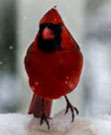 2/27 – Schenectady County, HRM 158: I am going to remember the winter of 2018-2019 in Glenville as the "Winter of the Cardinals." Most days I have seen ten and often more. This afternoon there were sixteen. (Photo of northern cardinal courtesy of Sheila Bogart) 2/27 – Schenectady County, HRM 158: I am going to remember the winter of 2018-2019 in Glenville as the "Winter of the Cardinals." Most days I have seen ten and often more. This afternoon there were sixteen. (Photo of northern cardinal courtesy of Sheila Bogart)
- Alan French (Hudson-Mohawk Bird Club)
2/28 – Ulster County, HRM 87: I was driving the back roads in High Falls this morning when I spotted an adult bald eagle standing in a pasture between two Black Angus bovids that were facing the eagle from several feet away. After a longer look, I noticed the eagle was standing on the carcass of what appeared to be a calf. I watched as the eagle leaned down for a tear at its meal. The eagle soon took flight, and the two onlookers moved to the calf, nosing it. I can only guess at the storyline leading up to that point.
- Mark Ruoff
2/28 – Yonkers, HRM 18: My students from the Bio-Chem program at Saunders High School in Yonkers checked our eel mop again today where we found our second glass eel of the season. The Saw Mill River was still 41 degrees Fahrenheit (F.).
- Harry Hall
[When Professor Hall told me that the Saw Mill River was 5.0 degrees Celsius (41.0 degrees Fahrenheit) on 2.26, I thought that must be in error. With the Hudson River still carrying ice, that had to be too warm. To be sure, we checked five upriver tributary creeks (Wappinger, Fishkill, Moodna, Quassaick, and Hathaway's Glen, river miles 58 to 67) with a reliable digital water thermometer to see what they were reading. They averaged 4.8 degrees Celsius, all well within the margin of error of the Bio-Chem students’ reading. The Saw Mill runs over flat, rather warm uplands, making their reading right on. Tom Lake, B.J. Jackson]
2/28 – Manhattan, HRM 1: With continued hopes for our first fish of 2019, we braved the freezing water to check our research sampling gear in Hudson River Park at The River Project's sampling station on the lighthouse tender Lilac at Pier 25. However, while the catch nicely mirrored the bottom of the river, there were no fish. Our killifish pots had collected an amazing assortment of shore shrimp, isopods, and amphipods.
- Siddhartha Hayes
3/1 – Putnam County, HRM 54: I had a coyote sighting this morning on Route 301 within the Clarence Fahnestock Memorial State Park.
- Lauren Martin
[On several occasions, while ice fishing at first light on Canopus Lake (Route 301), I have watched coyotes as they quietly walked across the lake investigating holes in the ice to see if anglers had left behind any fish, their lunch, or snacks. Tom Lake]
 3/1 – Furnace Brook, HRM 38.5: People ask if beavers can survive once their dam is removed: Yes, they do just fine, much as they did before all the human-constructed dams were built in the Hudson Valley in colonial times. Dam preparation by beavers can be witnessed on the lower reaches of Furnace Brook with many trees having been girdled and felled. Furnace Brook takes its name from an old furnace that was used to smelt iron around the time of the Revolutionary War. Before that, Furnace Brook was called Jamawissa Creek by native Americans [Algonquian], which translates as “place of small beaver.” Because of intense 17th century beaver trade, beaver were practically extirpated from the watershed. Now they are back on the Jamawissa, but I am not sure how big they are. (Photo of beaver courtesy of Deborah Tracy-Kral) 3/1 – Furnace Brook, HRM 38.5: People ask if beavers can survive once their dam is removed: Yes, they do just fine, much as they did before all the human-constructed dams were built in the Hudson Valley in colonial times. Dam preparation by beavers can be witnessed on the lower reaches of Furnace Brook with many trees having been girdled and felled. Furnace Brook takes its name from an old furnace that was used to smelt iron around the time of the Revolutionary War. Before that, Furnace Brook was called Jamawissa Creek by native Americans [Algonquian], which translates as “place of small beaver.” Because of intense 17th century beaver trade, beaver were practically extirpated from the watershed. Now they are back on the Jamawissa, but I am not sure how big they are. (Photo of beaver courtesy of Deborah Tracy-Kral)
- George Jackman (Riverkeeper)
[The beaver (Castor canadensis) is the official New York State mammal. A measure of their cultural importance was expressed by Iroquoian people, including Mohawk, Onondaga, and Seneca, where it was adopted as a clan name. However, beaver dams frequently hinder or block the flow of streams causing them to back up, flooding adjacent uplands and intruding on human habitat. In severe instances, where the loss of uplands is significant, dams are removed. Tom Lake]

Spring 2019 Natural History Programs
Volunteer Opportunity: Hudson River Eel Project
We are seeking volunteers to help study eels in streams of the Hudson River estuary! Volunteers check specialized nets for young transparent "glass eels" as they enter freshwater from their spawning grounds over 1,000 miles away in the Atlantic Ocean. Eels are counted, weighed, and released upstream, and environmental conditions are recorded. Sample sites include streams from NYC to Troy, and all gear is provided. See: https://www.dec.ny.gov/lands/49580.html
For more information, e-mail Aidan Mabey: aidan.mabey@dec.ny.gov
Hudson River: Striped Bass Cooperative Angler Program
You can share your fishing trip information and help biologists understand and manage our Hudson River striped bass fishery.
Here’s how it works: Fill out a logbook provided by us whenever you fish on the Hudson River (by boat or from shore). Record general location, time, gear used, what you caught (or if you didn’t catch anything) and return the logbook when you are done fishing for the season. You’ll receive an annual newsletter summarizing the information in addition to the latest news regarding regulations and the river. Whether you catch-and-release or take home a keeper, you can be part of the Cooperative Angler Program.
Join today by contacting: jessica.best@dec.ny.gov, or call 845-256-3009.
- Jessica Best
Hudson River Miles
The Hudson is measured north from Hudson River Mile 0 at the Battery at the southern tip of Manhattan. The George Washington Bridge is at HRM 12, the Tappan Zee 28, Bear Mountain 47, Beacon-Newburgh 62, Mid-Hudson 75, Kingston-Rhinecliff 95, Rip Van Winkle 114, and the Federal Dam at Troy, the head of tidewater, at 153. The tidal section of the Hudson constitutes a bit less than half the total distance – 315 miles – from Lake Tear of the Clouds to the Battery. Entries from points east and west in the watershed reference the corresponding river mile on the mainstem.
To Contribute Your Observations or to Subscribe
The Hudson River Almanac is compiled and edited by Tom Lake and emailed weekly by DEC's Hudson River Estuary Program. Share your observations by e-mailing them to trlake7@aol.com.
To subscribe to the Almanac (or to unsubscribe), use the links on DEC's Hudson River Almanac or DEC Delivers web pages.
Discover New York State Conservationist - the award-winning, advertisement-free magazine focusing on New York State's great outdoors and natural resources. Conservationist features stunning photography, informative articles and around-the-state coverage. Visit the Conservationist webpage for more information.
Useful Links
National Oceanic and Atmospheric Administration online tide and tidal current predictions are invaluable when planning Hudson River field trips.
For real-time information on Hudson River tides, weather and water conditions from sixteen monitoring stations, visit the Hudson River Environmental Conditions Observing System website.
DEC's Smartphone app for iPhone and Android is now available at: New York Fishing, Hunting & Wildlife App.
Adventure NY
Under Governor Cuomo's Adventure NY initiative, DEC is making strategic investments to expand access to healthy, active outdoor recreation, connect more New Yorkers and visitors to nature and the outdoors, protect natural resources, and boost local economies. This initiative will support the completion of more than 75 projects over the next three years, ranging from improvements to youth camps and environmental education centers to new boat launches, duck blinds, and hiking trails. Read more about the Adventure NY initiative. For more information on planning an outdoor adventure in New York State, visit DEC's website at http://www.dec.ny.gov/outdoor.
Information about the Hudson River Estuary Program is available on DEC's website at http://www.dec.ny.gov/lands/4920.html.
Copies of past issues of the Hudson River Almanac, Volumes II-VIII, are available for purchase from the publisher, Purple Mountain Press, (800) 325-2665, or email purple@catskill.net
|


 2/23 – Minerva, HRM 284: One of our cats is a pretty good mouser. This morning, I found a deceased short-tailed shrew on the kitchen floor, no doubt courtesy of the mouser. I had caught one this past summer in a standard trap, but here was one in mid-winter. Quite odd, I reckon. Meanwhile, we had three feet of snow on the ground. (Photo of short-tail shrew courtesy of Joel Satore)
2/23 – Minerva, HRM 284: One of our cats is a pretty good mouser. This morning, I found a deceased short-tailed shrew on the kitchen floor, no doubt courtesy of the mouser. I had caught one this past summer in a standard trap, but here was one in mid-winter. Quite odd, I reckon. Meanwhile, we had three feet of snow on the ground. (Photo of short-tail shrew courtesy of Joel Satore) 2/23 – New Paltz, HRM 78: We were at the Nyquist-Harcourt Wildlife Sanctuary when we spotted a northern shrike. The shrike was gurgling to itself and posing quite cooperatively. (Photo of northern shrike courtesy of Peter Heidrich)
2/23 – New Paltz, HRM 78: We were at the Nyquist-Harcourt Wildlife Sanctuary when we spotted a northern shrike. The shrike was gurgling to itself and posing quite cooperatively. (Photo of northern shrike courtesy of Peter Heidrich) 2/24 – Hudson River Watershed: We are fast approaching the season when educators, naturalists, scientists, and their students will catch, count, measure, and study “glass eels” in the Hudson River Estuary. This natural connection takes us to this week’s fish, the American eel (Anguilla rostrata), species number 19 (of 228) on our watershed list of fishes. (E-mail
2/24 – Hudson River Watershed: We are fast approaching the season when educators, naturalists, scientists, and their students will catch, count, measure, and study “glass eels” in the Hudson River Estuary. This natural connection takes us to this week’s fish, the American eel (Anguilla rostrata), species number 19 (of 228) on our watershed list of fishes. (E-mail  2/24 – Croton River, HRM 34: I found a coterie of fish crows this morning at the confluence of the Croton River and Croton Bay. To the crows, it was love in springtime: A pair were perched 30 feet away on a guardrail, stroking and caressing one another. In the canopy of a nearby cottonwood, another fish crow was presenting a bit of unidentifiable food to an admirer. “Ok-a-lee,” the call of the male red-winged blackbird, echoed from the tidemarsh. (Photo of fish crows courtesy of R.W. Sinclair)
2/24 – Croton River, HRM 34: I found a coterie of fish crows this morning at the confluence of the Croton River and Croton Bay. To the crows, it was love in springtime: A pair were perched 30 feet away on a guardrail, stroking and caressing one another. In the canopy of a nearby cottonwood, another fish crow was presenting a bit of unidentifiable food to an admirer. “Ok-a-lee,” the call of the male red-winged blackbird, echoed from the tidemarsh. (Photo of fish crows courtesy of R.W. Sinclair) 2/26 – Yonkers, HRM 18: When my 9 to 11th grade students from the Bio-Chem program at Saunders High School in Yonkers checked our eel mop today, it brightened an otherwise sunny and cold winter day: We found our first glass eel of the year! The water flowing out of the Saw Mill River into the Hudson was 41 degrees Fahrenheit (F.). (Photo of glass eel courtesy of Harry Hall)
2/26 – Yonkers, HRM 18: When my 9 to 11th grade students from the Bio-Chem program at Saunders High School in Yonkers checked our eel mop today, it brightened an otherwise sunny and cold winter day: We found our first glass eel of the year! The water flowing out of the Saw Mill River into the Hudson was 41 degrees Fahrenheit (F.). (Photo of glass eel courtesy of Harry Hall) 2/27 – Schenectady County, HRM 158: I am going to remember the winter of 2018-2019 in Glenville as the "Winter of the Cardinals." Most days I have seen ten and often more. This afternoon there were sixteen. (Photo of northern cardinal courtesy of Sheila Bogart)
2/27 – Schenectady County, HRM 158: I am going to remember the winter of 2018-2019 in Glenville as the "Winter of the Cardinals." Most days I have seen ten and often more. This afternoon there were sixteen. (Photo of northern cardinal courtesy of Sheila Bogart) 3/1 – Furnace Brook, HRM 38.5: People ask if beavers can survive once their dam is removed: Yes, they do just fine, much as they did before all the human-constructed dams were built in the Hudson Valley in colonial times. Dam preparation by beavers can be witnessed on the lower reaches of Furnace Brook with many trees having been girdled and felled. Furnace Brook takes its name from an old furnace that was used to smelt iron around the time of the Revolutionary War. Before that, Furnace Brook was called Jamawissa Creek by native Americans [Algonquian], which translates as “place of small beaver.” Because of intense 17th century beaver trade, beaver were practically extirpated from the watershed. Now they are back on the Jamawissa, but I am not sure how big they are. (Photo of beaver courtesy of Deborah Tracy-Kral)
3/1 – Furnace Brook, HRM 38.5: People ask if beavers can survive once their dam is removed: Yes, they do just fine, much as they did before all the human-constructed dams were built in the Hudson Valley in colonial times. Dam preparation by beavers can be witnessed on the lower reaches of Furnace Brook with many trees having been girdled and felled. Furnace Brook takes its name from an old furnace that was used to smelt iron around the time of the Revolutionary War. Before that, Furnace Brook was called Jamawissa Creek by native Americans [Algonquian], which translates as “place of small beaver.” Because of intense 17th century beaver trade, beaver were practically extirpated from the watershed. Now they are back on the Jamawissa, but I am not sure how big they are. (Photo of beaver courtesy of Deborah Tracy-Kral)